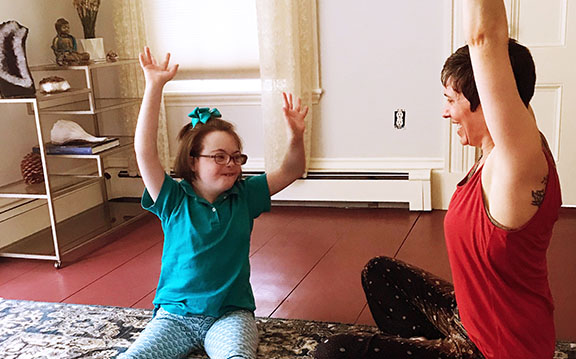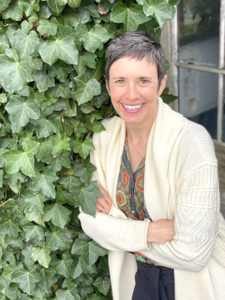
Photo: Gita teaching Yoga to Molly, another special needs student.
I looked over the damaged carrot patch. Bunnies had shorn the tops off; turning the frilly fronds into scant spikes. I sighed and wondered, Why do I bother? I was headed for trouble when I focused on “getting something” out of the garden. But this time the bunny damage felt personal, as I had promised the carrots to my youngest Yoga student, Jack.
Summer was waning and a breeze set the sunflowers dancing. It was cool and dry, a welcome relief from the humidity. Jack would be coming over soon for his Yoga class so I headed inside. I raised the windows to the library and the cool air billowed through the lace curtains. I lit sandalwood incense and watched the smoke coil and dance.
Jack is only seven years-old but one of my most dedicated Yoga students. He loves playing with his Labrador Retrievers and making blanket forts with his cousins. When he was born prematurely, he had a stroke which resulted in Cerebral Palsy. He uses a wheelchair, eats some food by mouth but also uses a feeding tube, and needs assistance for all of his daily activities. But his mind is bright and active.
It can often take time and patience for Jack to work through a series of yes/no questions or alternative devices to communicate ideas, ask questions, and have his inner world understood and validated—this is the challenge for people who have a label of being “nonverbal.” This is where the practices of Yoga for the Special Child, as taught to me by Sonia Sivakami Sumar come forth to align our spirit and physical selves into the present moment.
The first time Jack had visited my garden his mom had helped him over to the strawberry patch. She guided his hand to pluck a ripe berry and as he took a bite, he grimaced and spit it out. We laughed and she said, “Yeah, he’s way more of a veggie kid!” So we helped him over to the carrots and he smiled as his fingers tickled the fronds. I promised him that when they were ready for digging I’d give him some to take home.
As Jack and I moved through class that day we did all of the components of a Yoga for the Special Child class, which is closely aligned with Integral Yoga as its founder, Sonia, is a longtime student of Sri Swami Satchidananda. Jack sat on my lap and I assisted his head stability as we chanted Hari Om, his long Oms dissolving into peaceful silence. The incense wafted towards us in the breeze from the open window and he sighed deeply. His mom watched and occasionally snapped photos to share with her family.
Most of us take movement for granted, but with Jack it can take minutes of patient work to turn his head or flex his foot. I showed him each pose like I do to any Yoga kid; with a mix of playful seriousness that is the trademark of Sonia’s method. I supported him while allowing space for him to initiate movements; my voice praised each time he moved his hand, knee, or arm toward a position. As we moved through each position his breathing was steady and his attention was easeful yet alert.
The guided relaxation at the end of class is important for Jack, his muscles have a tendency towards spasticity which leads his arms, wrists, and fingers to clench tightly. As I chanted Om shanti (peace) and named each body part he chanted Om with me. His mom softly said, “Oh wow,” as his shoulders and arms visibly released. His relaxed focus during Yoga is the measure of the practice’s power; a form that allows our perception to move beyond limitation and into the power of now.
After class, Jack giggled and wiggled in what his mom and I call his “happy dance.” Then we wheeled him outside where the breeze had turned decidedly autumnal. It swirled around our feet and we joked that soon it would be time for sweatshirts and cocoa. Later that afternoon I pulled the bunny-eaten carrots, amid the soil with compost, and planted more seeds. The seeds were scarcely larger than a grain of dust, and the wind threatened to carry them away. I sheltered the row with my body and sprinkled them into the soil, tamped them down, and watered it gently.
Jack reminded me that all this Yoga stuff—and gardening—is not to “get something.” It’s not about chasing the brass ring of enlightenment or reaping a bushel of carrots. Nor is it the latest fitness craze that is just another self-improvement trap. Yoga practice is not an obligation or something we do because someone said once that it would “be good for us.”
A few weeks later the new carrots are up and growing, only this time surrounded by fencing. But now I know that “getting something” from my garden, or from my Yoga, is not the point. Trying to strive toward something, or trying to hold onto something, is as futile as trying to catch the sandalwood-scented wind. The practices are only there to provide a moment into which past and future can suspend; where we drop into the present. And in this moment we discover that the “something” that we have been striving toward has always been as close as our own heart.
What Jack and the carrots are teaching me is that the rewards of spiritual life do not lay outside of myself. They are to be found in the dedication of using practice to dwell fully in each moment and to be loving and supportive to each other on the mat, in the garden, and out in the world.
Author’s note: student’s name and other identifying features have been changed to protect their privacy.
About the Author:
 Gita Brown is a wellness activist, musician, and writer. She is a certified Advanced Integral Yoga® teacher and licensed Yoga for the Special Child® practitioner. Through her “Yoga with Gita courses” and podcast, “The Gita Brown Show,” her mission is to teach her students how to adapt the traditional practices of Yoga to bring more ease, wellness, and joy into everyday life. Gita started Yoga as a teenager, when her love of Yoga grew in tandem with her career as a classical clarinetist and music therapist. For three decades, she has taught Yoga, wellness, and music courses at colleges, schools of music, community schools, private studios, public schools, and hospitals. She is currently finishing final revisions to her memoir. The story is about how she repurposed her wedding vows into a yogic vow to live love as a way of life—a pilgrimage that endured even as her husband and childhood sweetheart battled end-stage alcoholism. She offers Yoga to students of all ages and abilities through online programs and in person at her home studio at Three Dog Farm in Kingston, Massachusetts. Learn more about her services by visiting: https://www.gitabrown.com
Gita Brown is a wellness activist, musician, and writer. She is a certified Advanced Integral Yoga® teacher and licensed Yoga for the Special Child® practitioner. Through her “Yoga with Gita courses” and podcast, “The Gita Brown Show,” her mission is to teach her students how to adapt the traditional practices of Yoga to bring more ease, wellness, and joy into everyday life. Gita started Yoga as a teenager, when her love of Yoga grew in tandem with her career as a classical clarinetist and music therapist. For three decades, she has taught Yoga, wellness, and music courses at colleges, schools of music, community schools, private studios, public schools, and hospitals. She is currently finishing final revisions to her memoir. The story is about how she repurposed her wedding vows into a yogic vow to live love as a way of life—a pilgrimage that endured even as her husband and childhood sweetheart battled end-stage alcoholism. She offers Yoga to students of all ages and abilities through online programs and in person at her home studio at Three Dog Farm in Kingston, Massachusetts. Learn more about her services by visiting: https://www.gitabrown.com

